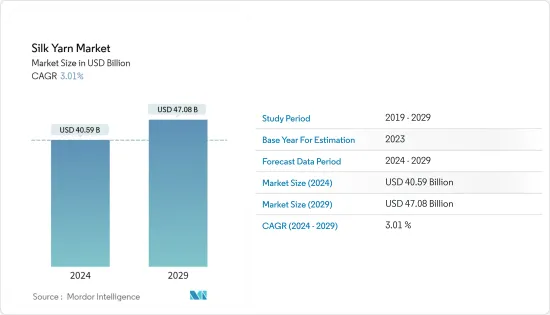 |
市場調查報告書
商品編碼
1439771
絲線:市場佔有率分析、產業趨勢與統計、成長預測(2024-2029)Silk Yarn - Market Share Analysis, Industry Trends & Statistics, Growth Forecasts (2024 - 2029) |
||||||
※ 本網頁內容可能與最新版本有所差異。詳細情況請與我們聯繫。
絲紗市場規模預計到2024年為405.9億美元,預計到2029年將達到470.8億美元,在預測期內(2024-2029年)年複合成長率為3.01%。

主要亮點
- 絲綢產業的工業化,加上各種政府計劃,將增加亞太地區生絲的產量,進而增加絲紗的產量,使該地區成為預測期內最大的市場。
- 古巴等加勒比海國家和肯亞等非洲國家正在努力擴大絲綢生產。同樣,盧安達政府已開始投資絲綢價值鏈的發展,該價值鏈將生產高品質的絲線,以滿足亞洲不斷成長的需求。 -高品質的絲綢產品提供了強勁的出口機會。為了開拓不斷成長的全球市場,盧安達國家農業出口發展委員會 (NAEB) 也與韓國絲綢製造商 HEWorks 合作。
- 由於該產業是印度等國家外匯存底的主要來源,因此政府正在支持各種促進該產業發展的措施。印度有 52,360 個村莊從事養蠶業。該國使用原料製造絲綢服裝類、化妝品、紡織品、紗線、地毯、披肩、圍巾、枕頭套和配件。
- 印度、中國、美國、美國、法國、瑞士、日本、越南、阿拉伯聯合大公國、英國、德國、韓國等國家是絲綢及絲綢製品的主要消費國。絲綢產業的工業化,加上各種政府計劃,將增加亞太地區生絲的產量,進而增加絲紗的產量,使該地區成為預測期內最大的市場。
絲綢市場趨勢
義大利正在成為歐洲領先的絲綢生產國
義大利是歐洲地區絲綢的主要生產國之一,近年來已有數百個農場開始養蠶。近年來,使用義大利種植的蠶生產的絲綢產量不斷增加。 ONGETTA SRL 等公司專注於絲綢慢蟄,並以 ONGETTA BIO SILK 品牌生產經過 GOTS 認證的有機絲綢。這是歐洲第一家獲得 GOTS 認證的絲紡加撚工廠。
隨著中國絲綢出口的下降,義大利絲綢生產商可能有更多機會進入全球市場。而且,中國絲綢的價格上漲,遠超過義大利產自義大利蠶絲的價格。如果這樣的話,國產絲線將會進一步成長。
然而,義大利的絲綢產量和出口量與中國的絲綢產量和出口量相比微不足道。 2021年,義大利向全球出口了價值1,821.4萬美元的絲紗。與2020年相比成長8%,主要出口目的地為法國、羅馬尼亞、英國、奧地利和德國。
亞太地區主導市場
中國是世界上最大的絲綢產品生產國和出口國,包括絲綢和絲線。然而,由於桑樹種植成本不斷上漲,許多農民被迫退出養蠶業。絲綢主要產於長江Delta南部地區。著名的絲綢產區有江蘇、浙江、四川等地。蘇州、杭州、南京、紹興等城市以絲綢產業聞名。
烏茲別克也是著名的絲綢生產國。這個國家的絲綢產品在世界市場上受到高度重視。該國最近成立了一個名為「烏茲別克Pasoat」的組織。該組織致力於改善蠶繭生產以及絲綢紡織品的加工和製造。與本地和國際製造商的合作正在進行中,並鼓勵和支持自營業絲綢生產商。烏茲別克是繼中國和印度之後的世界第三大絲綢生產國。
印度正在透過中央絲綢局(CSB)實施一項名為「Silk Samagra」的計劃,以提高國內絲綢的品質和生產率,從而減少生絲進口。為了促進奧里薩邦的 Tussar 絲綢種植,卡迪村工業委員會 (KVIC) 最近在該地區的喬德瓦爾建立了該州第一個絲綢生產中心。絲綢產業的工業化加上各種政府計畫將導致亞太地區生絲產量增加,從而帶動絲紗產量增加,使該地區成為預測期間最大的市場時期。
絲綢產業概況
其他福利
- Excel 格式的市場預測 (ME) 表
- 3 個月分析師支持
目錄
第1章簡介
- 研究假設和市場定義
- 調查範圍
第2章調查方法
第3章執行摘要
第4章市場動態
- 市場概況
- 市場促進因素
- 市場限制因素
- 價值鏈分析
第5章市場區隔
- 地區(產量分析、消費金額及數量分析、進口金額及數量分析、出口金額及數量分析、價格趨勢分析)
- 美國
- 中國
- 印度
- 泰國
- 德國
- 義大利
- 英國
- 巴西
- 突尼西亞
第6章市場機會與未來趨勢
The Silk Yarn Market size is estimated at USD 40.59 billion in 2024, and is expected to reach USD 47.08 billion by 2029, growing at a CAGR of 3.01% during the forecast period (2024-2029).

Key Highlights
- The industrialization of the silk industry coupled with various government schemes will boost the production of raw silk in the Asia-pacific region which in turn increase the production of silk yarn making the region to be the largest market during the forecast period.
- Caribbean countries such as Cuba and African Countries including Kenya are making an effort to boost their silk yarn production.The Government of Rwanda as well as has begun investing in the development of silk value chains, with the rising demand from Asia, the production of high-quality silk products offers strong export opportunities. To tap into growing global markets, Rwanda's National Agricultural Export Development Board (NAEB) has also partnered with HEWorks, a Korean silk manufacturer.
- The sector is a major provider to foreign exchange reserves in nations such as India which is why the government supports with various initiatives to boost the industry. In India, sericulture operations are distributed throughout 52,360 villages. The country uses raw materials to manufacture silk garments, made-ups, textiles, yarns, carpets, shawls, scarves, pillow coverings, and accessories.
- Countries such as India, China, the United States of America, Italy, France, Switzerland, Japan, Vietnam, the United Arab Emirates, the United Kingdom, Germany, and Korea are some of the major consumers of silk and silk products. The industrialization of the silk industry coupled with various government schemes will boost the production of raw silk in the Asia-pacific region which in turn increases the production of silk yarn, making the region to be the largest market during the forecast period.
Silk Yarn Market Trends
Italy is Emerging as Major Producer of Silk Yarn in Europe
Italy is one of the major producers of silk yarn in the European region, as hundreds of farms have started rearing silkworms in the past few years. Silk production using silk worms grown in Italy has been on the rise in recent years. Comapnies such as ONGETTA SRL is specialized in the silk throwsting and produces GOTS certified organic silk that is branded ONGETTA BIO SILK. It was the first spinning and twisting mill of GOTS certified silk yarns in Europe.
The decrease in exports of silk yarn from China is likely to give more access to the Italian silk yarn producers to the global market. Further, the price of Chinese silk has been climbing, far surpassing the price of silk threads produced in Italy from Italian-grown silkworms. This would further boost domestically produced silk yarn.
However, the production and export of silk yarn from Italy are minuscule when compared to Chinese production and export of silk yarn. In 2021, Italy exported silk yarn which valued at USD 18,214 thousand worldwide, which have increased by 8% as compared to 2020 and the major destinations were France, Romania, United Kingdom, Austria, and Germany.
Asia Pacific Dominates the Market
China is worlds largest producer and export silk and silk products including silk yarns. However, the rising costs of mulberry cultivation are forcing many farmers to exit sericulture.Silk is mainly produced in the south of the Yangtze River Delta. Renowned silk producing regions are Jiangsu, Zhejiang and Sichuan provinces. Cities such as Suzhou, Hangzhou, Nanjing, and Shaoxing are well known for their silk industries.
Uzbekistan is another prominent producer of silk. The silk products of the country are highly valued in the global market. In the nation, the organisation "UZBEKIPAKSANOAT" was founded recently. The organisation is working hard to improve silkworm cocoon production, as well as silk fabric processing and manufacturing. Collaboration with local and worldwide manufacturers is underway, and self-employed silk producers are encouraged and supported. After China and India, Uzbekistan is the world's third largest producer of silk.
India has implemented a scheme called Silk Samagra through its Central Silk Board (CSB) to enhance the quality and productivity of domestic silk to reduce the country's import of raw silk. In order to promote tussar silk cultivation in Odisha, the Khadi and Village Industries Commission (KVIC) in has recently established the State's first silk yarn production centre at Choudwar in the district .The industrialisation of the silk industry coupled with various government schemes will boost the production of raw silk in the Asia-pacific region which in turn increase the production of silk yarn making the region to be the largest market during the forecast period.
Silk Yarn Industry Overview
Additional Benefits:
- The market estimate (ME) sheet in Excel format
- 3 months of analyst support
TABLE OF CONTENTS
1 INTRODUCTION
- 1.1 Study Assumptions & Market Definition
- 1.2 Scope of the Study
2 RESEARCH METHODOLOGY
3 EXECUTIVE SUMMARY
4 MARKET DYNAMICS
- 4.1 Market Overview
- 4.2 Market Drivers
- 4.3 Market Restraints
- 4.4 Value Chain Analysis
5 MARKET SEGMENTATION
- 5.1 Geography (Production Analysis, Consumption Analysis by Value & Volume, Import Analysis by Value & Volume, Export Analysis by Value & Volume and Price Trend Analysis)
- 5.1.1 United States
- 5.1.2 China
- 5.1.3 India
- 5.1.4 Thailand
- 5.1.5 Germany
- 5.1.6 Italy
- 5.1.7 United Kingdom
- 5.1.8 Brazil
- 5.1.9 Tunisia













